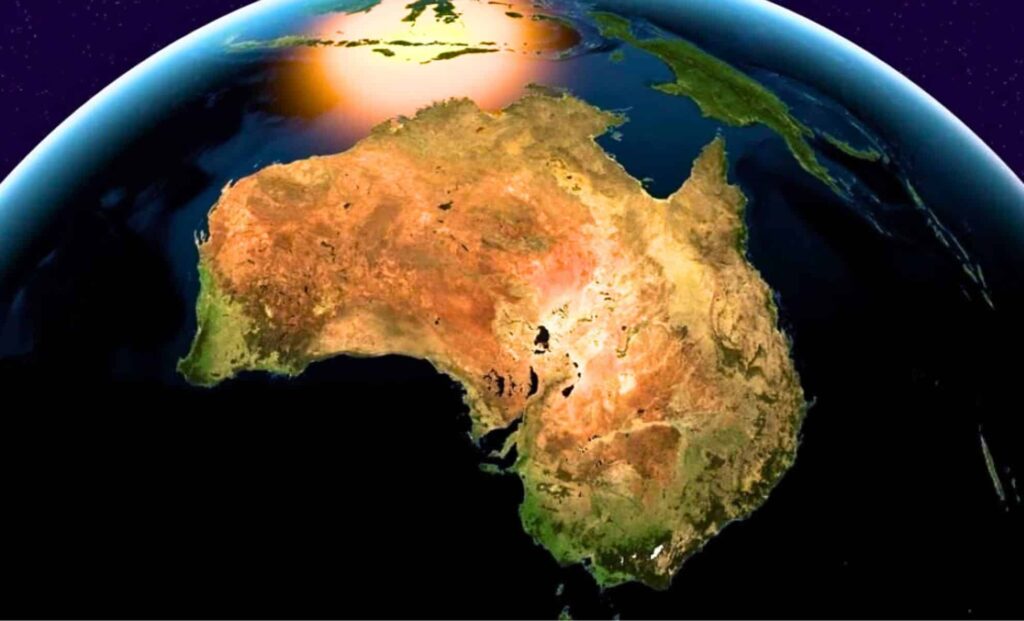Australia is inching closer to Asia at a pace too slow to feel, yet fast enough to throw off GPS systems and, in time, reshape the planet. According to leading geophysicists, the continent is drifting 7 centimeters per year — the same speed your fingernails grow — setting the stage for a tectonic collision that could transform landscapes, disrupt ecosystems, and eventually create a new supercontinent.
The data comes from long-term research led by Professor Zheng-Xiang Li at Curtin University, whose work on Earth’s ancient supercontinents has revealed that these massive landmasses don’t just break apart — they eventually regroup. Australia’s northward migration is a live example of this ongoing plate tectonic cycle, and it’s already producing real-world consequences.
In 2016, Australia had to update its entire national GPS grid after scientists found the country’s coordinates were out by nearly two meters. The reason? The continent had simply moved. While this may seem minor, it highlights the broader reality: Earth’s crust is always on the move, and Australia is currently one of the fastest-drifting pieces of land on the planet.
Continents in Slow Collision
Australia began its long trek northward after it split from Antarctica around 80 million years ago. Since then, it’s been advancing toward Southeast Asia, riding atop the Indo-Australian Plate, one of the planet’s major tectonic slabs. Though a full collision won’t happen for hundreds of millions of years, the effects are already being felt along the plate boundaries.
According to Li, who has spent decades studying the mechanics of plate movement, this creeping convergence is part of a much larger cycle. Earth’s continents have come together and broken apart multiple times in the past — the last major one forming Pangaea around 300 million years ago. Before that, there was Rodinia, another supercontinent that gathered the world’s landmasses some 900 million years ago.

In each case, the convergence of continents caused immense tectonic stress, triggering earthquakes, volcanism, and mountain formation. Already, parts of Indonesia and Papua New Guinea are experiencing subtle changes in seismic activity — a faint preview of what could eventually become a new collision zone.
Strange Days for Native Wildlife
One of the biggest questions posed by this continental migration is what happens when Australia’s unique wildlife comes face-to-face with the ecological giants of Asia. Isolated for millions of years, Australia’s marsupials — including kangaroos, wombats, and the platypus — have evolved in a bubble, free from most of the competition seen elsewhere.
But as landmasses shift and eventually merge, so to do ecosystems. Some researchers fear that Asian mammals could outcompete native species, leading to widespread extinctions. Others suggest that adaptable animals like tree kangaroos and possums might thrive in new niches. Species that rely on narrow environmental conditions, such as the koala, are unlikely to fare as well.
A study by CSIRO, Australia’s national science agency, outlines the vulnerability of endemic species under both climate stress and habitat disruption — both of which will only intensify as tectonic shifts alter coastlines, rainfall patterns, and bioregions.
Gps Errors and Digital Disorientation
For now, Australia’s movement is most noticeable not in earthquakes or extinct species, but in misaligned satellite data. The 2016 coordinate correction — led by Geoscience Australia — revealed just how sensitive our digital world is to geological reality.
As the continent keeps moving north, it will require regular coordinate updates to maintain the accuracy of autonomous vehicles, precision farming, aviation systems, and disaster response platforms. A report in Nature Geoscience emphasized that dynamic geospatial positioning is crucial in areas experiencing fast tectonic drift — like Australia.
Without real-time corrections, location-based systems could soon find themselves metres off target. That’s not just a software issue — it’s a safety and economic risk.
Assembling the Next Supercontinent
What lies ahead is something geologists call “Amasia” — a projected future supercontinent that may take shape in the next 300 to 500 million years. As Australia continues creeping north and North America slides westward, models suggest the Pacific Ocean will close, bringing today’s continents together once more in a global reshuffle.
When that happens, central land areas are expected to become hot, arid, and volcanically active, while new coastlines emerge and ocean circulation patterns shift. These events have occurred multiple times in Earth’s deep history, usually accompanied by massive climate change and species turnover.
“Earth is always evolving,” says Professor Li. “This isn’t the end of the story — it’s just the latest chapter in a cycle that has repeated itself for billions of years.”

